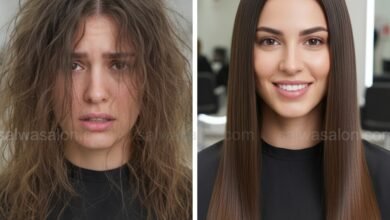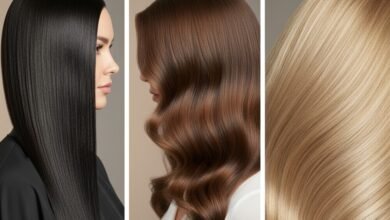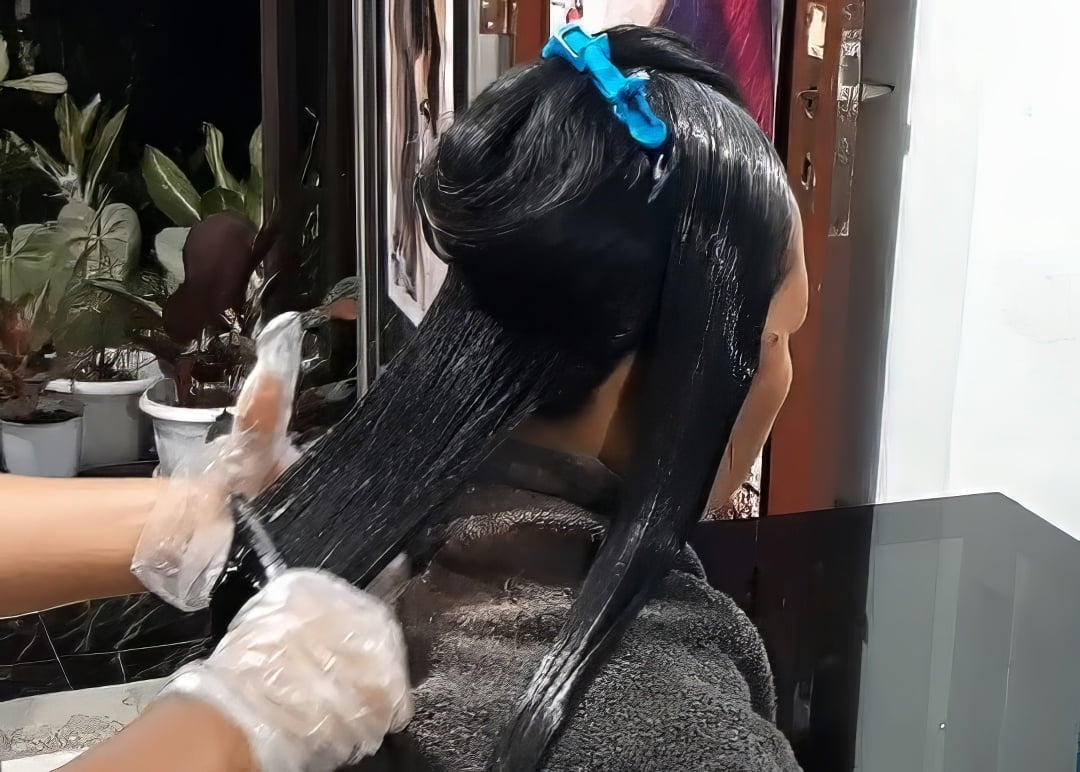Unveiling Myths: The Complete Guide to Simultaneous Hair Smoothing and Coloring for Optimal Results

The combination of soft, straight hair with a captivating color is a dream for many. However, a big question often arises: is it safe to perform hair smoothing and coloring treatments simultaneously? Concerns about hair damage often act as a barrier. At SalwaSalon.com, we understand this dilemma and are here to debunk myths and provide in-depth education based on evidence and best practices in the beauty industry.
We believe that with a proper understanding of the science behind hair treatments, strict safety protocols, and the expertise of professional hairstylists, the dream of having beautiful straight, colored hair can be realized without sacrificing your hair’s health. This article will be your comprehensive guide, discussing why this combination is often considered risky, how Salwa Salon addresses these challenges, and offering post-procedure care tips.
Understanding Hair Architecture: The Foundation of Chemical Treatments
Before we go further, let’s first understand the “what” and “why” behind your hair’s structure. Each strand of hair is a biological marvel consisting of three main layers:
- Cuticle: The outermost layer, arranged like overlapping fish scales. The cuticle functions to protect the inner part of the hair from damage. A healthy cuticle will appear smooth and shiny, while a damaged cuticle will open, making the hair vulnerable.
- Cortex: The thickest middle layer, containing keratin protein and melanin pigment which determine your hair’s natural color. The cortex is responsible for the hair’s strength, elasticity, and texture. Chemical processes like smoothing and coloring primarily work on this layer.
- Medulla: The innermost core layer, although not all hair types possess it. The function of the medulla is not yet fully understood, but it is suspected to play a role in hair flexibility.
How Do Chemical Treatments Work?
Both smoothing and coloring involve significant chemical changes to the hair structure:
- Smoothing/Straightening: This process aims to change the hair’s natural shape from curly or wavy to straight. Straightening chemicals (commonly containing thioglycolate or hydrosulfite) work by breaking the disulfide bonds in the hair’s cortex, which are responsible for the curly shape. Once the bonds are broken, the hair is physically straightened, and then the disulfide bonds are reformed using a neutralizer (usually hydrogen peroxide) in the straightened position. This process inherently weakens the hair structure and can cause dehydration.
- Coloring/Dyeing: This process aims to change the natural melanin pigment in the cortex or add new pigments. Permanent dyes work in two main ways: first, an alkaline agent (traditionally ammonia) opens the cuticle, allowing peroxide to penetrate the cortex. Second, the peroxide then oxidizes the hair’s natural pigments (removing them) and activates the artificial pigments that enter, thus forming a new color. This process also stresses the cuticle and cortex, making them more vulnerable and porous.
Considering the mechanisms above, it’s clear that both treatments open the cuticle and manipulate the cortex structure. Performing both simultaneously, without the right strategy, can lead to cumulative damage, ranging from extreme dryness, brittleness, to breakage.
Why Is the Combination of Smoothing and Coloring Often Considered Risky?
The common concerns regarding this combination of treatments are not without basis. Some risks often associated include:
- Excessive Damage (Over-processing): Exposure to two types of strong chemicals sequentially or simultaneously can cause hair to drastically lose its essential proteins and moisture, resulting in brittle, dry, coarse, and even broken hair.
- Thinning and Hair Loss: In extreme cases, over-processing can damage hair follicles, leading to severe hair thinning or even temporary baldness.
- Uneven or Fast Fading Color: Hair that has undergone the smoothing process tends to have higher porosity. This can cause the dye to penetrate too deeply in some areas and less in others, resulting in uneven color. High porosity also makes color pigments fade more easily.
- Scalp Irritation: The combination of strong chemicals can increase the risk of irritation, redness, or allergies on sensitive scalps.
Safe Transformation: Salwa Salon’s Philosophy for Dual Treatments
At SalwaSalon.com, we don’t reject the possibility of simultaneous smoothing and coloring treatments; instead, we approach it with a philosophy centered on safety, innovation, and optimal results. The key lies in four main pillars:
- Comprehensive Hair Assessment: Every hair is unique. We start with an in-depth analysis of your hair’s condition, chemical treatment history, and your expectations.
- High-Tech and Ammonia-Free Products: The use of premium quality products is the foundation.
- Innovative Application Techniques: Smart and modern application methods can reduce exposure time and stress on the hair.
- Professional Hairstylist Expertise: In-depth experience and knowledge are crucial factors for success.
The Revolutionary Role of Ammonia-Free and Bond-Building Products
One of the biggest breakthroughs in enabling safe dual treatments is the evolution of product formulations. Ammonia-free hair dye products have become a game changer. Instead of volatile and invasive ammonia to open the cuticle, these products use alternative alkaline agents like MEA (monoethanolamine) or ethanolamine that work more gently. Their advantages include:
- Minimal Cuticle Damage: The cuticle is opened more slowly and controllably, reducing the risk of permanent damage.
- Longer-Lasting Color: With a less stressed cuticle, color pigments can be locked better within the cortex.
- Safer for the Scalp: Reduces the risk of irritation and allergies.
- More Pleasant Scent: No strong, disturbing odor.
Furthermore, the integration of bond-building technology (such as maleic acid or bis-aminopropyl diglycol dimaleate) in both smoothing and coloring processes is crucial. These ingredients work by repairing disulfide bonds damaged during chemical processes, actively protecting and strengthening the hair structure from within. This not only minimizes damage but also enhances overall hair integrity.
Technique Innovation: Harabuki and Reflexion Painting for Efficiency & Beauty
Time is of the essence, and technique is art. At Salwa Salon, we have adopted and developed modern techniques to maximize results while minimizing time and risk. One such technique is Harabuki, a holistic approach that integrates several processes to be more efficient.
While conventional methods can take up to seven hours for separate smoothing and coloring, techniques like Harabuki allow completion in a much shorter time, even around four hours. This is not just about speed, but about optimization. Shorter chemical exposure time means less stress on the hair.
Then, there’s Reflexion Painting, a coloring technique adapted from the art of painting. Instead of uniformly coloring the entire hair after smoothing, Reflexion Painting allows our stylists to strategically apply color to specific areas, creating natural and appealing dimensions, highlights, or balayage effects. Its benefits:
- Minimized Exposure Area: Only targeted hair sections are exposed to the dye, reducing the chemical load on the entire hair.
- More Natural and Dynamic Results: Like a painting, color is applied with precision for a more vibrant and less rigid look.
- Design Flexibility: Provides artistic freedom to create color effects that suit individual preferences and post-smoothing hair texture.
Comprehensive Pre-Treatment Safety Protocols
The success of dual treatments heavily depends on preparation. Our protocols include:
- In-depth Consultation: A detailed discussion about your hair history (previous color, smoothing, henna, etc.), health condition, and expected results.
- Hair and Scalp Analysis: Visual and tactile assessment to determine porosity, elasticity, strength, and scalp condition.
- Strand Test: Product application on a hidden hair strand to predict smoothing and color results, as well as to test hair resilience. This is a crucial step.
- Patch Test (Allergy Test): To ensure no allergic reaction to the dye products, especially on sensitive skin.
- Pre-conditioning Treatment: In some cases, we will recommend pre-chemical treatments to strengthen the hair before the main procedure.
Post-Treatment Care: A Long-Term Investment for Hair Beauty
Achieving satisfactory results is the first step; maintaining them is the next. At-home care after dual smoothing and coloring is crucial:
- Use Products Specifically for Colored and Straightened Hair: Sulfate-free shampoos and conditioners designed for colored and chemically treated hair are a must. These products will help maintain color integrity and hair softness.
- Weekly Hair Masks: Apply a moisturizing or restorative protein/keratin-based mask at least once a week to restore hair moisture and strength.
- Avoid Excessive Heat: Limit the use of hot styling tools. If you must use them, always apply a heat protectant product.
- Protect Hair from UV Rays: Sun exposure can fade color. Use UV protection products or a hat when outdoors.
- Trim Hair Ends Regularly: This helps eliminate split ends and keeps hair healthy.
- Avoid Over-Shampooing: Shampoo every 2-3 days to prevent rapid color fading and preserve natural hair oils.
For more detailed guidance on in-depth post-chemical hair care strategies and recommended products, you can find exclusive guides in Salwa Salon’s Hair Care Ebook, which we will publish soon.
Choosing the Right Professional: The Key to Success
Ultimately, the most important factor in ensuring the success and safety of dual smoothing and coloring treatments is the expertise of your hairstylist. A professional hairstylist at Salwa Salon:
- Possesses a deep understanding of hair chemistry and products.
- Is capable of conducting accurate hair analysis.
- Is trained in modern application techniques such as Harabuki and Reflexion Painting.
- Prioritizes your hair’s health and integrity.
- Has a portfolio of work that demonstrates their expertise.
Don’t hesitate to ask questions, consult, and ensure you feel comfortable with your choice of hairstylist. This is an investment in your long-term hair beauty and health.
Conclusion
Performing hair smoothing and coloring simultaneously is no longer an impossible or inherently risky endeavor, provided it’s done with the right approach and by expert hands. At SalwaSalon.com, we combine scientific knowledge, innovative ammonia-free and bond-building products, and advanced techniques like Harabuki and Reflexion Painting to ensure you achieve straight, soft, beautifully colored, and healthy hair.
We encourage you to shed your doubts and open yourself to this transformative possibility. Consult your hair condition with our expert team at Salwa Salon. Together, we will design the most suitable treatment plan, ensuring you get results that are not only visually stunning but also healthy and long-lasting.






